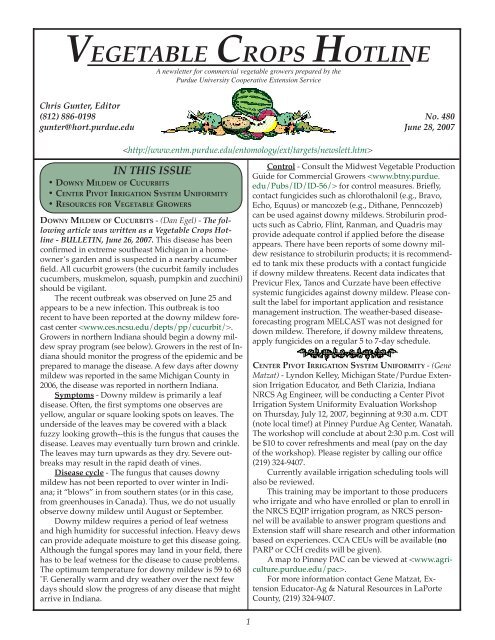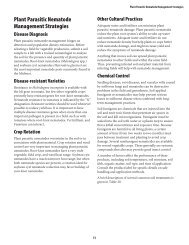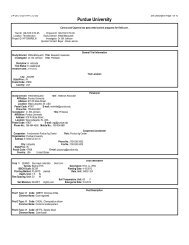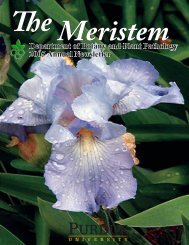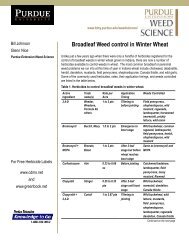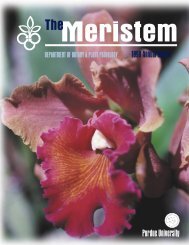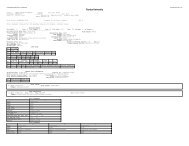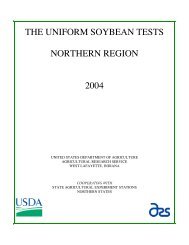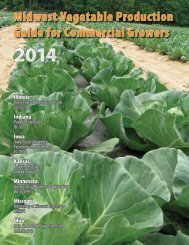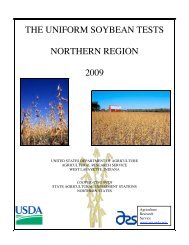Vegetable Crops Hotline - Purdue University Botany and Plant ...
Vegetable Crops Hotline - Purdue University Botany and Plant ...
Vegetable Crops Hotline - Purdue University Botany and Plant ...
Create successful ePaper yourself
Turn your PDF publications into a flip-book with our unique Google optimized e-Paper software.
<strong>Vegetable</strong> <strong>Crops</strong> <strong>Hotline</strong>A newsletter for commercial vegetable growers prepared by the<strong>Purdue</strong> <strong>University</strong> Cooperative Extension ServiceChris Gunter, Editor(812) 886-0198gunter@hort.purdue.eduNo. 480June 28, 2007IN THIS ISSUE• Downy Mildew of Cucurbits• Center Pivot Irrigation System Uniformity• Resources for <strong>Vegetable</strong> GrowersDowny Mildew of Cucurbits - (Dan Egel) - The followingarticle was written as a <strong>Vegetable</strong> <strong>Crops</strong> <strong>Hotline</strong>- BULLETIN, June 26, 2007. This disease has beenconfirmed in extreme southeast Michigan in a homeowner’sgarden <strong>and</strong> is suspected in a nearby cucumberfield. All cucurbit growers (the cucurbit family includescucumbers, muskmelon, squash, pumpkin <strong>and</strong> zucchini)should be vigilant.The recent outbreak was observed on June 25 <strong>and</strong>appears to be a new infection. This outbreak is toorecent to have been reported at the downy mildew forecastcenter .Growers in northern Indiana should begin a downy mildewspray program (see below). Growers in the rest of Indianashould monitor the progress of the epidemic <strong>and</strong> beprepared to manage the disease. A few days after downymildew was reported in the same Michigan County in2006, the disease was reported in northern Indiana.Symptoms - Downy mildew is primarily a leafdisease. Often, the first symptoms one observes areyellow, angular or square looking spots on leaves. Theunderside of the leaves may be covered with a blackfuzzy looking growth--this is the fungus that causes thedisease. Leaves may eventually turn brown <strong>and</strong> crinkle.The leaves may turn upwards as they dry. Severe outbreaksmay result in the rapid death of vines.Disease cycle - The fungus that causes downymildew has not been reported to over winter in Indiana;it “blows” in from southern states (or in this case,from greenhouses in Canada). Thus, we do not usuallyobserve downy mildew until August or September.Downy mildew requires a period of leaf wetness<strong>and</strong> high humidity for successful infection. Heavy dewscan provide adequate moisture to get this disease going.Although the fungal spores may l<strong>and</strong> in your field, therehas to be leaf wetness for the disease to cause problems.The optimum temperature for downy mildew is 59 to 68˚F. Generally warm <strong>and</strong> dry weather over the next fewdays should slow the progress of any disease that mightarrive in Indiana.Control - Consult the Midwest <strong>Vegetable</strong> ProductionGuide for Commercial Growers for control measures. Briefly,contact fungicides such as chlorothalonil (e.g., Bravo,Echo, Equus) or mancozeb (e.g., Dithane, Penncozeb)can be used against downy mildews. Strobilurin productssuch as Cabrio, Flint, Ranman, <strong>and</strong> Quadris mayprovide adequate control if applied before the diseaseappears. There have been reports of some downy mildewresistance to strobilurin products; it is recommendedto tank mix these products with a contact fungicideif downy mildew threatens. Recent data indicates thatPrevicur Flex, Tanos <strong>and</strong> Curzate have been effectivesystemic fungicides against downy mildew. Please consultthe label for important application <strong>and</strong> resistancemanagement instruction. The weather-based diseaseforecastingprogram MELCAST was not designed fordown mildew. Therefore, if downy mildew threatens,apply fungicides on a regular 5 to 7-day schedule.Center Pivot Irrigation System Uniformity - (GeneMatzat) - Lyndon Kelley, Michigan State/<strong>Purdue</strong> ExtensionIrrigation Educator, <strong>and</strong> Beth Clarizia, IndianaNRCS Ag Engineer, will be conducting a Center PivotIrrigation System Uniformity Evaluation Workshopon Thursday, July 12, 2007, beginning at 9:30 a.m. CDT(note local time!) at Pinney <strong>Purdue</strong> Ag Center, Wanatah.The workshop will conclude at about 2:30 p.m. Cost willbe $10 to cover refreshments <strong>and</strong> meal (pay on the dayof the workshop). Please register by calling our office(219) 324-9407.Currently available irrigation scheduling tools willalso be reviewed.This training may be important to those producerswho irrigate <strong>and</strong> who have enrolled or plan to enroll inthe NRCS EQIP irrigation program, as NRCS personnelwill be available to answer program questions <strong>and</strong>Extension staff will share research <strong>and</strong> other informationbased on experiences. CCA CEUs will be available (noPARP or CCH credits will be given).A map to Pinney PAC can be viewed at .For more information contact Gene Matzat, ExtensionEducator-Ag & Natural Resources in LaPorteCounty, (219) 324-9407.1
Web Sites<strong>Purdue</strong> Fruit <strong>and</strong> <strong>Vegetable</strong> Connection Web Sitewww.hort.purdue.edu/fruitveg<strong>Vegetable</strong> Insects <strong>and</strong> Their Managementhttp://www.entm.purdue.edu/entomology/vegisite/Resourcesfor<strong>Vegetable</strong> Growers<strong>Vegetable</strong> Pathology at <strong>Purdue</strong>http://www.btny.purdue.edu/Extension/vegpath.htmlSelected PublicationsMidwest <strong>Vegetable</strong> Production Guide for Commercial Growers (ID-56)http://www.btny.purdue.edu/Pubs/ID/ID-56/<strong>Vegetable</strong> <strong>Crops</strong> <strong>Hotline</strong> Newsletterhttp://www.entm.purdue.edu/entomology/Vegisite/commercial/hotline2007.htmlStarting a Farmers' Market (EC-739)http://www.ces.purdue.edu/extmedia/EC/EC-739.pdfElectronic Mail List for Fruit <strong>and</strong> <strong>Vegetable</strong> Farmershttp://www.hort.purdue.edu/fruitveg/fvmaillist.shtmlUpcoming Educational Programs(Watch for details in <strong>Purdue</strong> newsletters, or contact 219-785-5673, or purduenwhort@pnc.edu)Pumpkin <strong>and</strong> Sweet Corn Twilight Meeting, September 11, 2007, WanatahIlliana <strong>Vegetable</strong> Growers’ School, January 3, 2008, ScherervilleIndiana Horticultural Congress, January 28-30, 2008, IndianapolisSouthwest Indiana Melon <strong>and</strong> <strong>Vegetable</strong> Meeting, March, 2008, VincennesIt is the policy of the <strong>Purdue</strong> <strong>University</strong> Cooperative Extension Service, David C. Petritz, Director, that all persons shall have equal opportunity <strong>and</strong> access to theprograms <strong>and</strong> facilities without regard to race, color, sex, religion, national origin, age, marital status, parental status, sexual orientation, or disability. <strong>Purdue</strong> <strong>University</strong>is an Affirmative Action employer. 1-888-EXT-INFO Disclaimer: Reference to products in this publication is notintended to be an endorsement to the exclusion of others which may have similar uses. Any person using products listed in this publication assumes full responsibilityfor their use in accordance with current directions of the manufacturer.<strong>Vegetable</strong> <strong>Crops</strong> <strong>Hotline</strong>c/o Chris GunterSouthwest <strong>Purdue</strong> Agricultural Program4369 N <strong>Purdue</strong> RdVincennes, IN 47591


